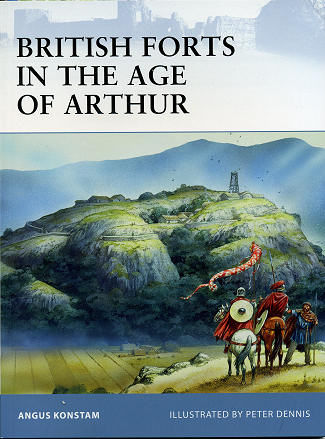 #80
in the Fortress series concentrates on those defensive positions used once the
Romans had left the British Ises around 410 AD. As much as the Romans provided
the population of this land, they did not leave it completely subjugated and so
there was still fear of attack from outside forces. While Roman fortresses were
well designed and able to withstand siege, they were also very manpower
intensive and required constant upkeep, something that in what was now a barter
society, was not able to be maintained.
#80
in the Fortress series concentrates on those defensive positions used once the
Romans had left the British Ises around 410 AD. As much as the Romans provided
the population of this land, they did not leave it completely subjugated and so
there was still fear of attack from outside forces. While Roman fortresses were
well designed and able to withstand siege, they were also very manpower
intensive and required constant upkeep, something that in what was now a barter
society, was not able to be maintained.
The result was that, for the most part, the leaders of the
time reverted to the defensive positions, mostly hill forts, that were used
prior to the Roman arrival. These were generally earthworks structures that
relied on ditches and wooden walls. They were also often located on natural
defensive positions such as the tops of cliffs, or large hills or other places
where terrain provided as much help as possible. These were also relatively
small as they were not designed to encompass the entire population of the area,
but only the leadership and their small defensive force. While this may seem
cruel, most battling left the local population pretty much alone as it was
realized that the local peasants were needed to provide for any new regime
change.
The fact that any of the works are still
extant is pretty amazing. Some were built atop existing Roman stonework and some
of these are still visible. Others, are little more than some rather unusual
earthen structures while others have been totally obliterated by the passage of
time. Even doing research on these structures is difficult as there is little to
go on in terms of a historical record and much of what is know has to be gleaned
from tales and fables that mix reality with imagination.
The author does an excellent job in this regard and allows us
to look at several places of interest, discussing their design and what it was
like to live within the walls. This is further enhanced by photographs of the
sites as they are today and the superb illustrations of artist Peter Dennis.
This makes for a most interesting book on what it must have been like during the
times of what are often referred to as the 'Age of Arthur' or the era of Late
Antiquity.
It makes for a fascinating read and is a book that I
enjoyed quite a bit. I know that you will as well.
January 2009
For more on the complete line of Osprey books,
visit www.ospreypublishing.com. In the US, it is
Osprey Direct at 44-02 23rd St, Suite 219, Long Island City, NY 11101., where you can
get a catalogue of available books.
If you would like your product reviewed fairly and quickly, please contact
me or see other details in the Note to
Contributors.
 #80
in the Fortress series concentrates on those defensive positions used once the
Romans had left the British Ises around 410 AD. As much as the Romans provided
the population of this land, they did not leave it completely subjugated and so
there was still fear of attack from outside forces. While Roman fortresses were
well designed and able to withstand siege, they were also very manpower
intensive and required constant upkeep, something that in what was now a barter
society, was not able to be maintained.
#80
in the Fortress series concentrates on those defensive positions used once the
Romans had left the British Ises around 410 AD. As much as the Romans provided
the population of this land, they did not leave it completely subjugated and so
there was still fear of attack from outside forces. While Roman fortresses were
well designed and able to withstand siege, they were also very manpower
intensive and required constant upkeep, something that in what was now a barter
society, was not able to be maintained.